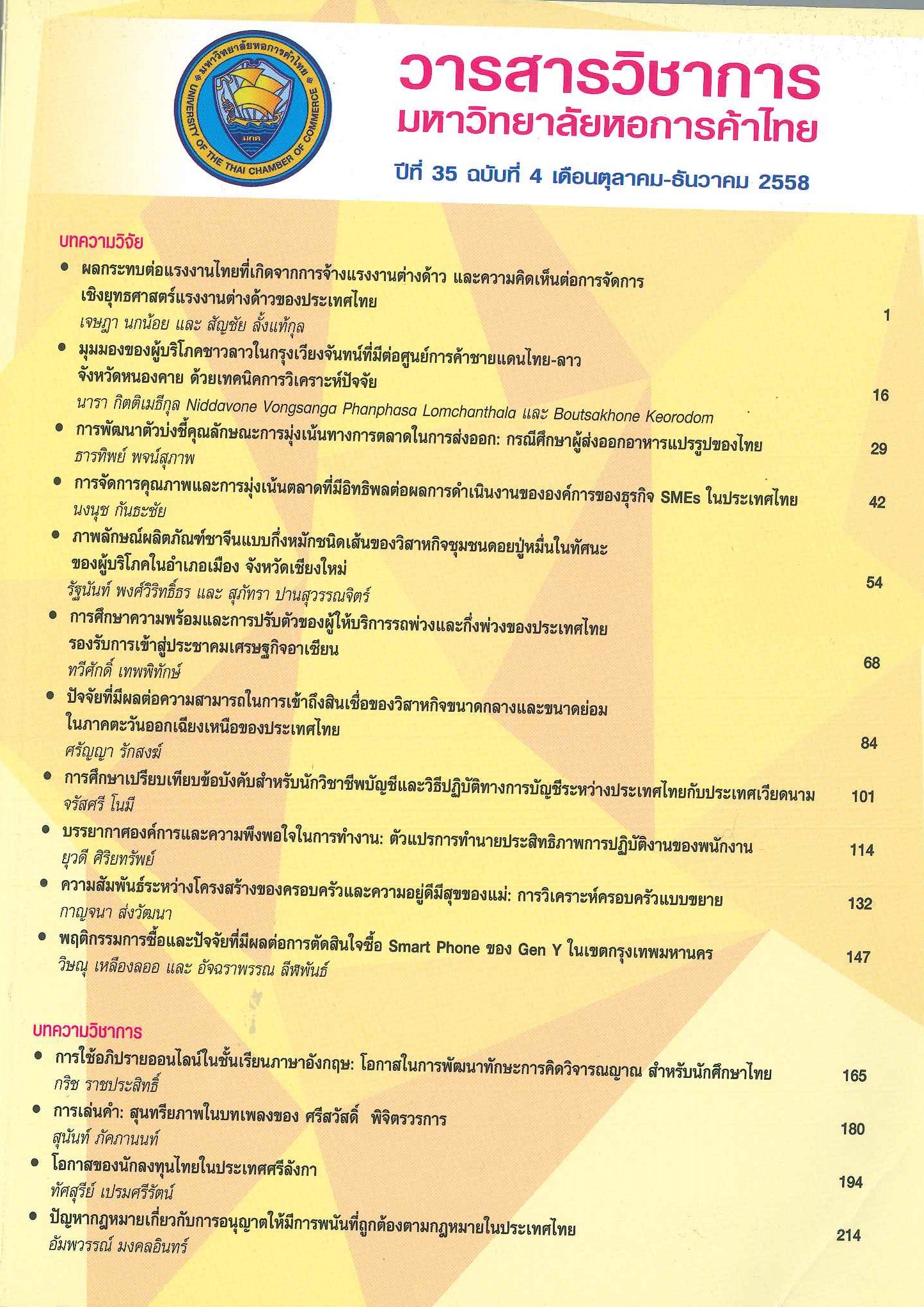The Development of Characteristics Indicators of Export Market Orientation: A Case Study of Thai Processed Food Exporters
Main Article Content
Abstract
This research objectives were to develop characteristics indicators of export market orientation (EMO). A quantitative method of analysis was employed for a total of 528 Thai processed food exporters by multistage random sampling. Data was collected using 5-point likert scales in a questionnaire with 15 items, and analyzed by first-order and second-order confirmatory factor analysis (FOCFA and SOCFA) using a structural equation modeling approach. The results demonstrated that the characteristics indicators of export market orientation consisted of three latent variables, including export market intelligence generation (ExIntel), export market intelligence dissemination (ExDiss) and export market responsiveness and coordinating mechanism (ExResp). The test of the SOCFA model implied that three latent variables were a good fit for measuring the export market orientation construct. There were several indicators of goodness-of-fit which indicated a good fit : df= 59 p = 0.000 NFI = 0.992 NNFI = 0.994 CFI = 0.997 RMSEA = 0.039 RMR = 0.029 SRMR = 0.033 GFI = 0.974 AGFI = 0.947. The composite reliability values were between 0.727 and 0.951, in which all CR values were above the suggested minimum of 0.70, and the average variance extracted values were between 0.367 and 0.866, in which most of the AVE values were above 0.50. The goodness-of-fit indices indicated that the research model was congruent to empirical data.
Article Details

This work is licensed under a Creative Commons Attribution-NonCommercial-NoDerivatives 4.0 International License.
ลิขสิทธิ์ของบทความ
ผลงานที่ได้รับการตีพิมพ์ถือเป็นลิขสิทธิ์ของมหาวิทยาลัยหอการค้าไทย ห้ามมิให้นำเนื้อหา ทัศนะ หรือข้อคิดเห็นใด ๆ ของผลงานไปทำซ้ำ ดัดแปลง หรือเผยแพร่ ไม่ว่าทั้งหมดหรือบางส่วนโดยไม่ได้รับอนุญาตเป็นลายลักษณ์อักษรจากมหาวิทยาลัยหอการค้าไทยก่อน
References
Cadogan, J.W., Diamantopoulos, A. and Pahudde Mortanges, C. 1999. "A Measure of Export Market Orientation: Scale Development and Cross-Cultural Validation.” Journal of International Business Studies 30, 4: 689-707.
Hair, J.F. et al. 2006. Multivariate Data Analysis. 6th ed. Upper Saddle River, NJ.: Prentice Hall.
Jaworski, B.J. and Kohli, A.K. 1993. "Market Orientation: Antecedents and Consequences.” Journal of Marketing 57, July: 53-70.
Kohli, A.K. and Jaworski, B.J. 1990. "Market Orientation: The Construct, Research Propositions, and Managerial Implications.” Journal of Marketing 54, April: 118-.
Kohli, A.K., Jaworski, B.J. and Kumar, A. 1993. "MARKOR: A Measure of Market Orientation.” Journal of Marketing Research 30, November: 467-477.
Narver, J.C. and Slater, S.F. 1990. "The Effect of Market Orientation on Business Profitability.” Journal of Marketing 54, 4: 20-35.
Pitiphat, Samart. 2012. "Identifying Indicators of Strategic Factors Determining Demand for Vietnamese Foods : Applied Second order Confirmatory Factor Analysis Model.” University of Thai Chamber of Commerce Journal 32, 3: 15-33.
(in Thai).
สามารถ ปติพัฒน์. 2555. "การพัฒนาตัวบ่งชี้ปัจจัยเชิงกลยุทธ์ที่กำหนดอุปสงค์อาหารเวียดนาม : การประยุกต์ใช้แบบจำลองการวิเคราะห์องค์ประกอบเชิงยืนยันอันดับสอง." วารสารวิชาการ มหาวิทยาลัยหอการค้าไทย 32, 4: 15-33.
Schermelleh-Engel, K., Moosbrugger, H. and Müller, H. 2003. "Evaluating the Fit of Structural Equation Models: Test of Significance and Descriptive Goodness- of-Fit Measures.” Methods of Psychological Research - Online 8, 2: 23-74.
Wiratchai, Nonglak. 1999. LISREL : Statistical Analysis for Research. Bangkok: Chulalongkorn University Printing.
(in Thai).
นงลักษณ์ วิรัชชัย. 2542. โมเดลลิสเรล : สถิติวิเคราะห์สำหรับการวิจัย. กรุงเทพมหานคร: โรงพิมพ์แห่งจุฬาลงกรณ์มหาวิทยาลัย.


